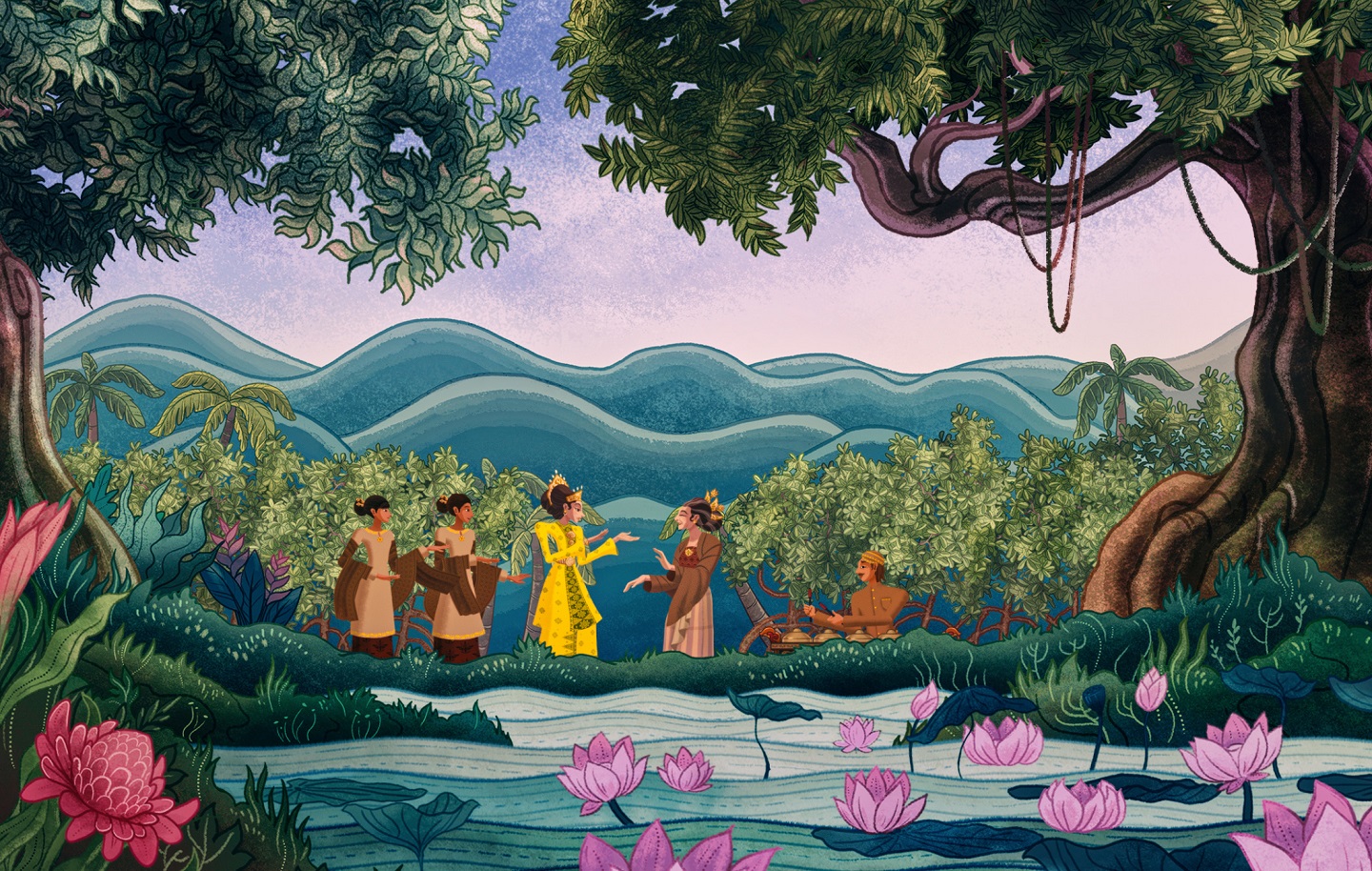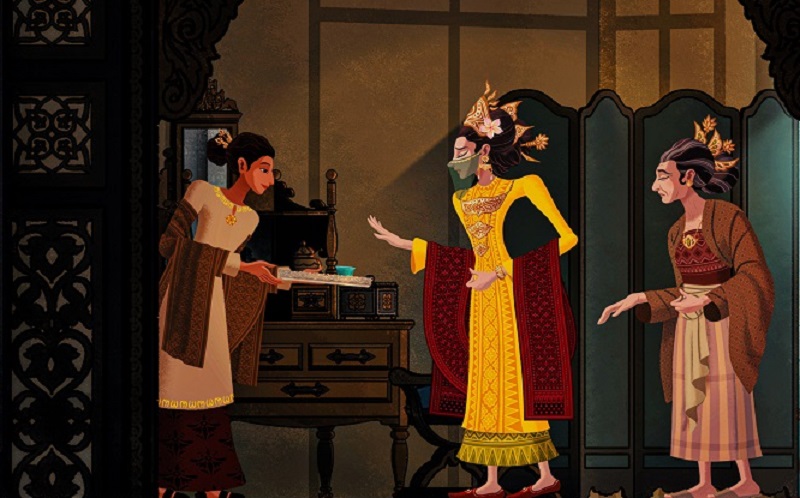
One of the lesser-known Malay princesses, Walinong Sari was a renowned warrior (Photo: Walinong Sari)
The beguiling tale of Walinong Sari, a Pahang warrior princess from the kingdom of Inderapura who defied all odds to follow her heart, is the subject of an award-winning animated short film directed by artist, animator and educator Eugene Foo in collaboration with scriptwriter Honey Ahmad. Based on a story in folklorist Ninot Aziz’s book Lipur Lara Nusantara, Walinong Sari recently won the award for best original soundtrack at the New York International Short Film Festival and best animated short at the Los Angeles International Film Festival, among others.
Longtime collaborators on various other projects, Foo — a former lecturer at the Faculty of Creative Industries, Universiti Tunku Abdul Rahman — and Honey were able to produce Walinong Sari courtesy of a 2021 grant from the Malaysian Communications and Multimedia Commission intended to reinvigorate the creative industry during the pandemic.
One of the lesser-known Malay princesses, Walinong Sari was a renowned warrior. Despite defeating all the eligible suitors for her hand in marriage, her father still accepted a proposal from the Bendahara of Melaka. Accepting her fate this time, Walinong Sari went on a final trip down the Pahang River and attracted the attention of Mambang Segara, the prince of the skies. Disguising himself as a beggar, Mambang Segara struck a friendship with Walinong Sari, and the two soon fell in love. But according to Raja Laksamana Petir, Mambang Segara’s father and the king of the skies, a union between the two was forbidden. Eventually, Walinong Sari received the guidance and blessings she needed from her father in a dream, who reluctantly let his daughter find her own path and follow her heart — even if it meant leaving him, and Inderapura, forever.
honey_ahmad_new.jpg

Choosing Walinong Sari as the subject of their collaboration, according to Honey, was a decision based on multiple factors.
“Firstly, it’s about a warrior princess who is not very well known,” begins Honey. “We have had a golden age of kick-ass princesses in our own folklore that we haven’t investigated fully. Cik Siti Wan Kembang is famous for her costumes, but in actual fact, she was the only woman to have ruled a state in our country. In Walinong Sari’s case, she was raised to rule Inderapura, which is a great example to share. Then there’s the mystical aspect of the story with Mambang Segara, prince of the skies.
“The story is actually quite basic, but folklore is always a bit ambiguous as it’s up to the storyteller, the penglipur lara, to fill in the blanks. I told Eugene since we are the penglipur lara in this instance, it was up to us. So, I wrote to his strengths as an artist and animator and, on his part, he worked around my narrative-driven writing style. There was a lot of stuff to mine even from the base story: a princess who was asked to get married but thought she could do better. The lesson here is that as a ruler, you have to make decisions for the people and the kingdom, not just yourself. On the dad’s part, you must learn when to let go of your children and let them find their own path,” she adds.
The embellishments to the story, Foo and Honey say, are necessary owing to the restrained nature of traditional folklore. The opportunity here was to make the story of Walinong Sari more relatable to a contemporary audience with plot twists and little details. The close relationship between the princess and her father is one example, while the depiction of the princess’ sheer determination is another. Even as Mambang Segara comes to woo her, Foo and Honey rethought the gifts he might have presented her with.
inside_new.jpg

“If you read the original story, it’s typical folklore — there is no emotional bond highlighted,” Foo says. “We also embellished certain parts to make them more relatable — would Mambang Segara give someone like Walinong Sari simple presents? It felt to me that the original gifts would be something a more subservient woman might have appreciated. Instead, Honey wrote about how the prince wooed her with puzzles instead, as a means of building an intellectual connection with her. And these items would have been accessible at the time because Nusantara was a trading hotspot.”
Based on Honey’s detailed script, Foo’s visual language for the film takes cues from wayang kulit puppetry and the artwork of Nanyang-style pioneer Cheong Soo Pieng, resulting in a style that is easily accessible and recognisably Southeast Asian. In terms of animation style, Foo went down the 2D route after a great deal of thought.
“There were both economic and artistic reasons to do this,” he shares. “Economically, I needed a style I could manage during the pandemic that would not be technically too difficult, or that I could maybe get my students to also work on. Artistically, I wanted a style very reflective of our local culture, and 3D isn’t it. If you look at shadow puppets and our collective art history, it’s quite flat — unlike, for example, Baroque or Renaissance paintings. In terms of flora and fauna, I looked to Peranakan fabric for inspiration.”
Honey agrees with this, pointing out that 3D animation tends to have a very Western vibe to it. “We wanted something distinctly Southeast Asian, which was important to us. When you see Manga, you definitely know it for what it is, and we wanted to create a film whose animation could immediately be associated with Malaysia and Southeast Asia. 3D tends to make everything look smoother and it’s more Western, somehow.”
20220819_165232.jpg

Uniquely, Foo reached out to the theatre community for the voice talents to bring Walinong Sari to life. With direction from actor Gavin Yap, the cast includes Nadia Aqilah as the protagonist, Bront Palarae as her father, Ghafir Akbar as the Prince of the Skies and Fatimah Abu Bakar as the penglipur lara, or the narrator.
The challenge now is access and how Foo and Honey can get as many people to watch Walinong Sari as possible — standing in the way of private and public screenings is accreditation by the censorship board, which is prohibitively expensive. At present, Foo is in talks to organise screenings at Ilham Gallery and it is hoped that other art institutions are able to provide a similar setting for the film to be shown.
The reimagining of traditional folklore is increasingly popular all over the world and Honey says the time is now to harness the strength of our own stories before they are interpreted by someone else. “I think the legacy of princesses needs to be examined much more,” adds Foo, who has two daughters. “Ninot’s books have reinspired the conversation around our folklore and the characters that emerge from it, so I hope to see more content generators telling these stories for both local and international audiences.”
This article first appeared on Aug 29, 2022 in The Edge Malaysia.


